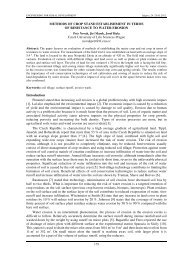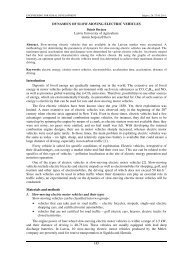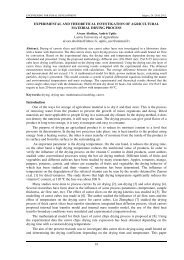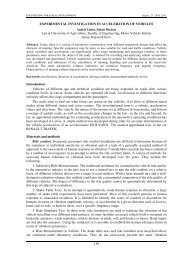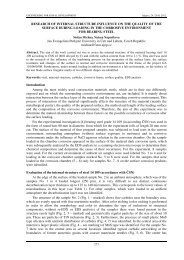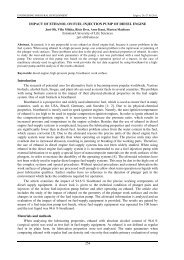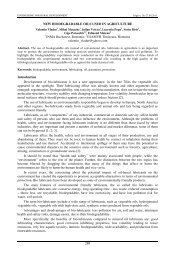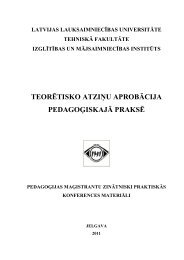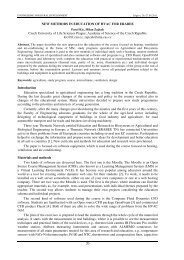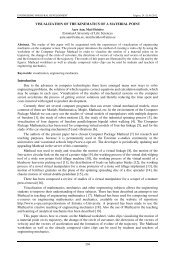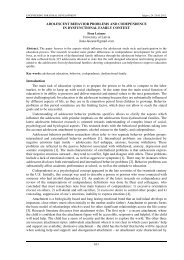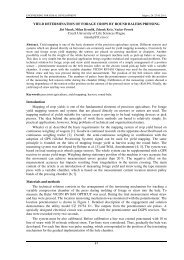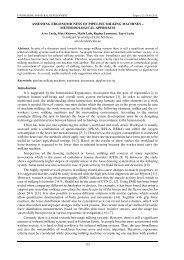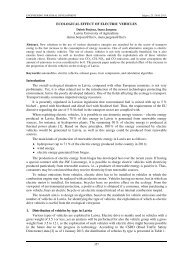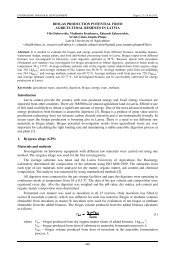Vladimir Baks, Ilmars Dukulis, Aivars Birkavs Latvia University
Vladimir Baks, Ilmars Dukulis, Aivars Birkavs Latvia University
Vladimir Baks, Ilmars Dukulis, Aivars Birkavs Latvia University
You also want an ePaper? Increase the reach of your titles
YUMPU automatically turns print PDFs into web optimized ePapers that Google loves.
ENGINEERING FOR RURAL DEVELOPMENT Jelgava, 26.-27.05.2011.<br />
EMISSION AND FUEL CONSUMPTION STUDIES USING SEPARATED AT LOW<br />
TEMPERATURES PURE RAPESEED OIL<br />
<strong>Vladimir</strong> <strong>Baks</strong>, <strong>Ilmars</strong> <strong>Dukulis</strong>, <strong>Aivars</strong> <strong>Birkavs</strong><br />
<strong>Latvia</strong> <strong>University</strong> of Agriculture<br />
bladimirs_baks@inbox.lv, ilmars.dukulis@llu.lv, aivars.birkavs@llu.lv<br />
Abstract. Pure rapeseed oil is an environmentally friendly alternative fuel. Its production and storing processes<br />
are not toxic for flora and fauna. One of the problems to use rapeseed oil as a biofuel is its higher melting point<br />
in comparison with fossil diesel fuel. If the length of the fatty acids chains is the same, increasing of double<br />
bounds quantity lowers the melting and solidification temperature that allows the use of vegetable oil containing<br />
unsaturated fatty acids as fuel without warming up at lower ambient temperatures. However, when vegetable oils<br />
are highly unsaturated, they solidify at lower temperatures, but have high oxidative instability – they quickly<br />
break down. Another problem is fuel consumption – rapeseed oil is less economical than diesel fuel and some<br />
emission parameters running the engine on rapeseed oil are worse than using diesel. The difference of the<br />
melting temperature allows separating such components as sulphur and phosphor as integral components of<br />
molecules. Sulphur in rapeseed oil is in the form of organic compounds, which are decomposition products of<br />
glucosinolates. Fractionation can help remove waxes and other nontriglycerides, naturally occurring highmelting<br />
point triglycerides formed during hydrogenation – in such a way it is possible to get rapeseed oil with<br />
different properties than for conventional one. The research results show that for oil improvement material and<br />
time resources are consumed, but no significant benefits for fuel economy and exhaust gas composition were<br />
observed, that is why such an oil enriching method is applicable only during the winter months, because it allows<br />
using the oil as a fuel at lower temperatures.<br />
Keywords: rapeseed oil, fractionation, exhaust gases.<br />
Introduction<br />
Vegetable oils by 95 to 97 % consist of fatty acid triglycerides. The residues of fatty acids are<br />
responsible for the chemical and physical properties of oils. If the length of the fatty acid chains is the<br />
same, increasing of double bound quantity lowers the melting and solidification temperature that<br />
allows the use of vegetable oil containing unsaturated fatty acids as a fuel without warming up at<br />
lower ambient temperatures. Such a fact is very important for using rapeseed oil as an environment<br />
friendly fuel in winter months. February of 2011 with average monthly air temperature -8.9°C (4.1<br />
degrees below the normal) was the 13 th <strong>Latvia</strong>n coldest one in the last 88 years. In such a way the<br />
rapeseed oil as a fuel cannot be used. That is why it is necessary to modify such kind of fuel for using<br />
it in winter months, too [1].<br />
It is possible to divide rapeseed oil into fractions after solidification. Fractionation (winterizing as<br />
it is sometimes called) helps remove the high-melting point triacilglycerols (TAGs) – in such a way<br />
we can get the liquid phase which is more resistant to lower temperatures. The process involves<br />
chilling the fat and then separating the two phases by filtration. One of the key factors determining the<br />
success of the fractionation process is the efficiency of separation. During this cycle, agitation is<br />
introduced by either very slow rotation of mechanical agitators or by bubbling cold air through the<br />
cell. After a certain period, the temperature difference is changed for the crystal maturing phase, and<br />
the agitation may be reduced or stopped. Although the TAGs form the main crystalline phase, the<br />
minor components, or impurities, can often play a large role in how crystallization occurs and<br />
crystallization may be substantially different in refined oil than in the unrefined starting material.<br />
Lutton stated that if the fatty acids of a TAG differ in length by more than four carbons, it forms a<br />
triple chain-length structure. Triple chain-length packing is also observed in TAG containing a<br />
cis-unsaturated fatty acid because this causes a kink in the structure. Cis-unsaturated fatty acids do not<br />
mix in one layer with saturated fatty acids, and triple chain-length crystals are formed. It should be<br />
noted that trans-unsaturated fatty acids incorporate into a crystal structure in the same way as the<br />
saturated fatty acids [2].<br />
Transformation of unstable to stable polymorphs can be achieved by a slight increase in<br />
temperature above the melting point of the less stable forms. This increase in temperature first causes<br />
the melting of the unstable forms and then solidification in a more stable form [2; 3].<br />
239
ENGINEERING FOR RURAL DEVELOPMENT Jelgava, 26.-27.05.2011.<br />
Saturated fatty acids have a straight hydrocarbon chain. A trans-double bond is accommodated<br />
with a little change in the shape, but natural fatty acid residues of pure plant oils are usually located in<br />
cis-configuration of the molecular form. Cis-configuration is the dimensional position, when the<br />
radicals are located on one side of the double bond. This situation causes ‘the windings’ in the<br />
molecular geometry – therefore the chains cannot go closer and establish hydrophobic intermolecular<br />
contacts. Rapeseed oil contains a large amount of cis-configured unsaturated fatty acids as linolenic<br />
acid; therefore it has higher fluidity [2; 3].<br />
Trans-acids have melting points much closer to those of the corresponding saturates.<br />
Polymorphism results in two or more solid phases with different melting points. Methyl esters are<br />
lower melting than fatty acids but follow similar trends [2; 4; 5].<br />
Getting more unsaturated form of rapeseed oil is important because this form has lower viscosity,<br />
and deep freezing is harmful for rapeseed oil as a biofuel. The kinematical viscosity can be increased<br />
with elongation of chains, hydrogenation, polymerisation or oxidation. The first two reactions need<br />
specific conditions, but heating stimulates the polymerisation or oxidation process. So, it can be<br />
suggested that deep freezing stimulates conversion of cis-unsaturated forms into trans-unsaturated<br />
TAGs forms as these structures have viscosity comparable with fully saturated. The previously made<br />
experiments showed, that the kinematical viscosity of the fluid was changed from 59.56 mm 2 ·s -1 (pure<br />
rapeseed oil) to 58.78 mm 2 ·s -1 (rapeseed oil after freezing and phase separation) [6].<br />
The LEAR type rape (low erucic acid rapeseed) is the most popular in <strong>Latvia</strong>. The high tolerance<br />
of erucic acid to temperature makes it suitable for transmission oil. Its ability to polymerize and dry<br />
means: it can be and is used as a binder for oil paints. Being a hydrocarbon of a high calorific value,<br />
with a very low flash point, high cetane number, and good lubrication qualities, erucic acid can be a<br />
valuable component of biodiesel. But as high erucic varieties of rape are rich in this C22 monoene<br />
acid, the viscosity of HEAR (high erucic acid rapeseed) oil is significantly higher than that of canola<br />
oil – from this point of view LEAR can be more perspective for usage as a biofuel [5; 7].<br />
Alternative fuel sphere researches in the whole world are directed on decreasing the dependence<br />
on oil extraction industry, updating the world economics and defending environment from pollution.<br />
Environmental pressures demand cleaner processes, and there is a market for new ‘green’ chemistry<br />
products. The usage of pure plant oils is a way to live in close connection with nature. Generally,<br />
renewable fuels are produced to reduce greenhouse gas emissions, improve combustion of fuels, and<br />
extend supplies of fossil fuels, although their production may also be used to subsidize the production<br />
of agricultural commodities and improve the balance of trade for countries that produce little fossil<br />
fuel.<br />
The subject of the research is emission and fuel consumption studies using separated at low<br />
temperatures pure rapeseed oil in comparison with conventional rapeseed oil and fossil diesel fuel.<br />
Materials and methods<br />
During the experiment the LEAR type rapeseed oil from rape grown in <strong>Latvia</strong> was used. It can be<br />
used for both purposes: as a food product and biofuel.<br />
To get rapeseed oil with lower viscosity than pure rapeseed oil has, using the experience from the<br />
previously made experiments [6], 15 l of pure rapeseed oil were taken. This oil was frozen in a freezer<br />
at –12 ºC. After 36 hours, when the crystallization process of oil takes a visual maximum (the oil was<br />
constant in 5 hours), the solid phase was separated. From 15 l of pure rapeseed oil 9 l of oil with lower<br />
viscosity (further – enriched) were obtained. The output of the product was 60 %.<br />
The enriched oil was compared with diesel fuel and conventional pure rapeseed oil. The points of<br />
comparing were the fuel consumption and components of exhaust gases.<br />
During the experiment the Opel 16 DA diesel engine was used. The Opel 16 DA diesel engine is a<br />
single line 4/OHC engine, having a capacity of 1598 cm 3 , the compression ratio – 23 and the power of<br />
40 kW. The engine fuel system was powered by a fuel pump Bosch VE 4/9R215. The research was<br />
done on the test bench. The engine was equipped with Elsbett two-tank system (Fig. 1), but the engine<br />
revolution frequency was measured by the stroboscope DG 85.<br />
240
ENGINEERING FOR RURAL DEVELOPMENT Jelgava, 26.-27.05.2011.<br />
The fuel consumption was determined using the KERN 440-49A electronic weighing system<br />
which provides measurements with an accuracy of 0.1 g at intervals of 1 second. The weighing system<br />
management and data registration is computer controlled.<br />
The exhaust gases were measured using the AVL SESAM (System for Emission Sampling and<br />
Measurement) multicomponent exhaust gas measurement system. This system is based on the FTIR<br />
(Fourier Transform Infrared Spectroscopy) optical measurement method that gives an opportunity to<br />
detect a large amount of exhaust gases components at intervals of 1 second.<br />
2<br />
Fig. 1. Engine test bench:<br />
1 – Elsbett two-tank system; 2 – diesel engine; 3 – weighing system<br />
During the experiment the engine revolution frequencies 900 rpm, 1600 rpm and 2500 rpm were<br />
used.<br />
The results of the measurements were automatically saved in a digital format and imported in a<br />
spreadsheet program for analyzing.<br />
Results and discussion<br />
The data in Table 1 show that the fuel consumption of the enriched rapeseed oil (compared with<br />
pure rapeseed oil) was less at all test modes.<br />
Table 1<br />
Fuel consumption measurement results<br />
Fuel 900 rpm 1600 rpm 2500 rpm<br />
Diesel, g·h -1<br />
396.8 1028.1 1558.6<br />
Rapeseed oil, g·h -1<br />
559.0 1115.1 1735.5<br />
Enriched rapeseed oil, g·h -1<br />
558.7 1071.4 1723.7<br />
The largest fuel consumption difference was observed at 1600 rpm, when between the reached<br />
and pure rapeseed oil it was 4 %. It was higher than the diesel fuel consumption only by 4 %. At 900<br />
rpm and 2500 rpm the difference between the enriched and conventional rapeseed oil was not<br />
significant.<br />
As the working hypothesis suggested, the enriched rapeseed oil would not be worse than<br />
conventional rapeseed oil also comparing the exhaust emissions, therefore all three fuel types were<br />
tested at the same engine working modes.<br />
241<br />
1<br />
3
ENGINEERING FOR RURAL DEVELOPMENT Jelgava, 26.-27.05.2011.<br />
CO, ppm<br />
Fig. 2. CO and CO2 measurement results: D – diesel fuel, RO – rapeseed oil, ROE – enriched oil<br />
Comparing the amount of CO2 and CO in exhaust gases (Fig. 2), that affect each other, CO<br />
quantity using the enriched rapeseed oil was a little bit higher (what is correlating with a little bit less<br />
CO2) as for the conventional rapeseed oil. But in absolute numbers the amount of CO2 and CO was<br />
very close. Of course, both values are higher in comparison with diesel fuel.<br />
MP, ppm<br />
Fig. 3. MP and HCD measurement results: D – diesel fuel, RO – pure oil, ROE – enriched oil<br />
The data in Figure 3 show that the quantity of MP (mechanical particles) at 900 rpm and 1600<br />
rpm using diesel fuel was less than for both oils. At 2500 rpm the content of MP in emissions<br />
decreased about twice and it was practically equal (even a little less) with diesel fuel. The quantity of<br />
HCD (unburned hydrocarbons) at 900 rpm using diesel fuel was less than for both oils, but at 1600<br />
and 2500 rpm the content of HCD using the enriched rapeseed oil was correspondingly less by 8 %<br />
and 41 % than for diesel.<br />
NOX, ppm<br />
1600<br />
1400<br />
1200<br />
1000<br />
800<br />
600<br />
400<br />
200<br />
200<br />
180<br />
160<br />
140<br />
120<br />
100<br />
80<br />
60<br />
40<br />
20<br />
0<br />
0<br />
40<br />
35<br />
30<br />
25<br />
20<br />
15<br />
10<br />
5<br />
0<br />
397<br />
10<br />
195<br />
1 110<br />
32<br />
115<br />
1 113<br />
26<br />
115<br />
542<br />
19<br />
114<br />
1 248<br />
34<br />
109<br />
1 479<br />
36<br />
97<br />
632<br />
17<br />
114<br />
732<br />
16<br />
900 1600 2500<br />
rpm<br />
D RO ROE<br />
136<br />
900 1600 2500<br />
rpm<br />
D RO ROE<br />
766<br />
900 1600 2500<br />
rpm<br />
D RO ROE<br />
17<br />
127<br />
Fig. 4. NOx and SO2 measurement results: D – diesel fuel, RO – rapeseed oil, ROE – enriched oil<br />
As it can be seen from Figure 4, at 900 and 1600 rpm for both oils the content of NOx was less<br />
than for diesel, but at 2500 rpm small increasing of NOx was observed – the difference between diesel<br />
fuel and pure rapeseed oil was 16 %, but between diesel fuel and the enriched oil – 11 %.<br />
242<br />
CO2, ppm<br />
HCD, ppm<br />
SO2, ppm<br />
25500<br />
25000<br />
24500<br />
24000<br />
23500<br />
23000<br />
22500<br />
22000<br />
21500<br />
21000<br />
550<br />
500<br />
450<br />
400<br />
350<br />
300<br />
250<br />
200<br />
150<br />
100<br />
50<br />
0<br />
0.25<br />
0.2<br />
0.15<br />
0.1<br />
0.05<br />
0<br />
275<br />
0.080<br />
24 112<br />
326<br />
0.005<br />
24 374<br />
335<br />
0.014<br />
24 046<br />
436<br />
0.020<br />
22 424<br />
378<br />
0.015<br />
23 204<br />
401<br />
0.016<br />
22 998<br />
512<br />
0.030<br />
23 895<br />
279<br />
900 1600 2500<br />
rpm<br />
D RO ROE<br />
0.220<br />
24 984<br />
900 1600 2500<br />
rpm<br />
D RO ROE<br />
300<br />
900 1600 2500<br />
rpm<br />
D RO ROE<br />
24 955<br />
0.154
ENGINEERING FOR RURAL DEVELOPMENT Jelgava, 26.-27.05.2011.<br />
At 900 and 1600 rpm the content of SO2 using both oils was less than for fossil diesel. The<br />
2500 rpm mode showed a very sharp increase also for this component – by 86 % for rapeseed oil and<br />
80 % for the enriched oil. The SO2 content difference between the enriched oil and unimproved oil was<br />
30 %.<br />
The CO, CO2, SO2 and MP content analysis at 2500 rpm shows, that in conditions of temperature<br />
increasing (1) the available CO quantity for SO2 electrons accepting in a reduction-oxidation reaction<br />
(2) was decreasing; therefore the SO2 content is growing, and the amount of MP (and pure sulphur as a<br />
part of this measurement) is decreasing.<br />
2 CO + O2 → 2 CO2 ↑ (1)<br />
SO2 + 2 CO → 2 CO2 ↑ + S ↓ (2)<br />
Conclusions<br />
1. When operating the engine on the enriched rapeseed oil the fuel consumption in average was<br />
about 2 % lower compared to the conventional rapeseed oil. The largest difference, i.e., 4 % was<br />
observed at the 1600 rpm, but for both oils the consumption is still much higher than for fossil<br />
diesel fuel.<br />
2. The impact of using the enriched rapeseed oil on environment is almost the same as using the<br />
conventional rapeseed oil, because decreasing in average the amount of CO2, mechanical particles<br />
and NOx, other components – CO, unburned hydrocarbons and SO2 – slightly increase.<br />
3. Considering that for the oil improvement material and time resources are consumed, but no<br />
significant benefits for fuel economy and exhaust gas composition were observed, such an oil<br />
enriching method is applicable only during the winter months, because it allows to use the oil as a<br />
fuel at lower temperatures.<br />
References<br />
1. Laika apstākļu raksturojums 2011. gada februārī Latvijā (Weather characteristics of February<br />
2011th in <strong>Latvia</strong>). [online] [18.03.2011]. Available at: http://www.meteo.lv/public/31208.html (in<br />
<strong>Latvia</strong>n).<br />
2. Bailey`s industrial oil and fat products, 6 th Edit., Vol. 3, John Wiley & Sons, Inc. 2008. – 621 p.<br />
3. Грин Н., Стаут У., Тейлор Д. Биология (Biology), 2 том. Москва: Мир, 2004, 430 с. (in<br />
Russian).<br />
4. Звонов В.А., Козлов А.В., Теренченко А.С. Исследование эффективности применения в<br />
дизельных двигателях топливных смесей и биотоплив (Investigation of the efficiency of the<br />
use of fuel blends and biofuels in diesel engines). Российский химический журнал, 2008, Nr. 6,<br />
c. 147-151. (In Russian).<br />
5. Плотность масел и воска (The density of oils and waxes). [online] [18.03.2011]. Available at:<br />
http://www.habit.ru/35/183.html (in Russian).<br />
6. <strong>Baks</strong> V., <strong>Dukulis</strong> I. The Specific Peculiarities of Rapeseed Fuel Usage Depending on Oil<br />
Chemical Structure. In: 9 th International Scientific Conference „Engineering for Rural<br />
Development”: Proceedings, Volume 9, May 27 – 28, 2010. Jelgava: LUA, p. 162 – 165.<br />
7. Enerģētisko augu audzēšana un izmantošana (Cultivation and use of energy plants). Rīga: Vides<br />
projekti, 2007. 190 lpp. (In <strong>Latvia</strong>n).<br />
243



